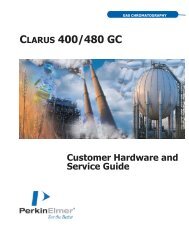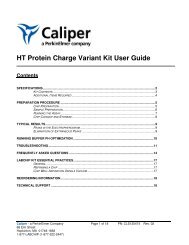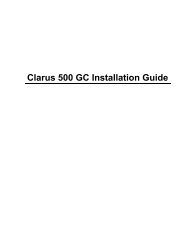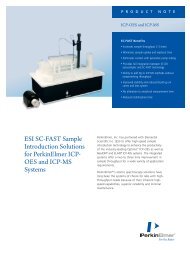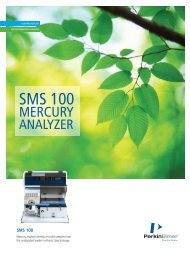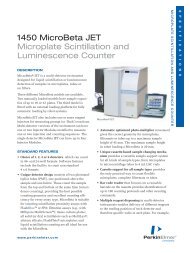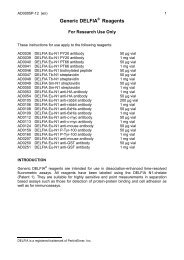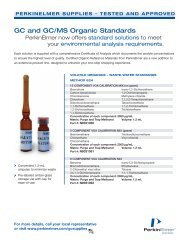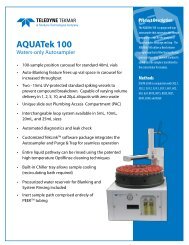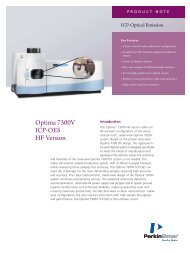Analysis of Sunscreen Agents with the PerkinElmer Flexar FX-15 ...
Analysis of Sunscreen Agents with the PerkinElmer Flexar FX-15 ...
Analysis of Sunscreen Agents with the PerkinElmer Flexar FX-15 ...
You also want an ePaper? Increase the reach of your titles
YUMPU automatically turns print PDFs into web optimized ePapers that Google loves.
application Note<br />
Ultra High Performance<br />
Liquid Chromatography<br />
Author<br />
Njies Pedjie<br />
<strong>PerkinElmer</strong>, Inc.<br />
Shelton, CT USA<br />
<strong>Analysis</strong> <strong>of</strong> <strong>Sunscreen</strong><br />
<strong>Agents</strong> <strong>with</strong> <strong>the</strong><br />
<strong>PerkinElmer</strong> <strong>Flexar</strong><br />
<strong>FX</strong>-<strong>15</strong> System Equipped<br />
<strong>with</strong> a PDA Detector<br />
Introduction<br />
Azobenzene and benzophenone are<br />
chemical compounds that can absorb<br />
ultraviolet light. They are used in<br />
sunscreen cream to prevent cutaneous<br />
disorders, including skin cancer and<br />
premature aging caused by sunlight.<br />
However, <strong>the</strong>y are not a panacea for all<br />
cutaneous ailments caused by <strong>the</strong> sun.<br />
These chemical compounds do not<br />
protect against <strong>the</strong> full spectrum <strong>of</strong><br />
UV light, especially when <strong>the</strong> exposure time is increased. While sunscreen can<br />
enhance <strong>the</strong> protection from UV light, its usage is not <strong>with</strong>out risks. Some<br />
studies suggest that some benzophenones are potential estrogenic disruptors<br />
that can also interfere <strong>with</strong> <strong>the</strong> thyroid hormone function by inhibiting <strong>the</strong><br />
thyroid peroxidase enzyme. Moreover, because <strong>the</strong>y reduce <strong>the</strong> exposure to<br />
UV, sunscreen agents can cause vitamin D deficiency since vitamin D syn<strong>the</strong>sis<br />
in <strong>the</strong> body is initiated by ultraviolet rays from sunlight that reach <strong>the</strong> skin.<br />
The usage <strong>of</strong> sunscreen agents comes <strong>with</strong> health concerns that in many<br />
countries are addressed in a regulatory framework that limit <strong>the</strong> concentration<br />
at which <strong>the</strong>y can be used safely. In <strong>the</strong> U.S., <strong>the</strong> FDA and Cosmetic Act<br />
(FD&C Act) states that it is against <strong>the</strong> law to market products <strong>with</strong> ingredients<br />
that may cause injuries under label conditions. It is <strong>the</strong>refore important for <strong>the</strong><br />
cosmetic industry to develop robust analytical methods to monitor <strong>the</strong> type and<br />
amount <strong>of</strong> sunscreen agents in cosmetics to ensure that <strong>the</strong>ir levels are safe and<br />
comply <strong>with</strong> regulations.
This application note presents a method for <strong>the</strong><br />
simultaneous analysis <strong>of</strong> five sunscreen agents from <strong>the</strong><br />
benzophenone and azobenzene groups (Figure 1) using a<br />
superficially porous particle column. Method conditions and<br />
performance data including precision, linearity and accuracy<br />
are presented.<br />
2,4-Dihydroxybenzophenone<br />
Azobenzene<br />
2,2-Dihydroxy-4-<br />
methoxybenzophenone<br />
2,2',4,4'-<br />
Tetrahydroxybenzophenone<br />
2-hydroxy-4-<br />
methoxybenzophenone<br />
Figure 1. Molecular structures <strong>of</strong> <strong>the</strong> sunscreen compounds analyzed.<br />
Experimental<br />
A stock solution <strong>of</strong> 1 mg/mL <strong>of</strong> each compound was<br />
prepared by transferring <strong>the</strong> appropriate net weight into<br />
a 10 mL volumetric flask, to which some diluent (70:30<br />
methanol/water) was added, <strong>the</strong> solution was mixed well<br />
and sonicated for five min. The solution was left to return<br />
to room temperature and brought to volume <strong>with</strong> diluent.<br />
Similarly, an internal standard <strong>of</strong> 1 mg/mL <strong>of</strong> benzoic acid<br />
was prepared. The working standard was prepared by<br />
transferring 1.0 mL <strong>of</strong> each stock solution and 1.0 mL <strong>of</strong><br />
<strong>the</strong> internal standard into 10 mL vol. flask, <strong>the</strong> solution was<br />
brought to volume <strong>with</strong> diluent and mixed well. Precision<br />
was evaluated <strong>with</strong> five injections <strong>of</strong> <strong>the</strong> working standard.<br />
Linearity was determined across <strong>the</strong> concentration range<br />
<strong>of</strong> 2.5 µg/mL to 100 µg/mL. Accuracy was evaluated by<br />
spiking one gram <strong>of</strong> corn oil in a 10 mL vol. flask <strong>with</strong><br />
2.0 mL <strong>of</strong> working standard solution as to obtain (when<br />
brought to vol. <strong>with</strong> diluent) a final solution <strong>of</strong> 20 µg/mL<br />
<strong>of</strong> sunscreen agent or 0.02% sunscreen in <strong>the</strong> oil. Samples<br />
were thoroughly mixed and centrifuge for 10 min. at<br />
5000 RPM; <strong>the</strong> aliquot was filtered through a 0.2 µm nylon<br />
membrane prior to testing. Because Azobenzene consists<br />
in two photoisomers, <strong>the</strong> cis isomer and <strong>the</strong> trans isomer,<br />
<strong>the</strong> standard was exposed to light overnight prior to testing<br />
to convert as much <strong>of</strong> <strong>the</strong> cis form as possible to <strong>the</strong> more<br />
stable trans form.<br />
A <strong>PerkinElmer</strong> ® <strong>Flexar</strong> <strong>FX</strong>-<strong>15</strong> UHPLC system fitted <strong>with</strong> a<br />
<strong>Flexar</strong> <strong>FX</strong> PDA photodiode array detector was <strong>the</strong> platform<br />
for this experiment. The separation was achieved using a<br />
<strong>PerkinElmer</strong> Brownlee SPP C-18, 50 x 2.1 mm column <strong>with</strong><br />
2.7 µm superficially porous particles.<br />
Table 1. Detailed UHPLC system and chromatographic<br />
conditions.<br />
Autosampler: <strong>Flexar</strong> <strong>FX</strong> UHPLC<br />
Setting: 50 µL Loop and <strong>15</strong> µL needle<br />
volume, partial loop mode 350 µL mixer<br />
volume<br />
Injection 2 µL; injector wash and carrier:<br />
water<br />
PDA Detector: Scanned from 190 – 700 nm, recording<br />
setting 240 nm<br />
Reference 400 nm, bandwidth 10 nm<br />
UHPLC Column: <strong>PerkinElmer</strong> Brownlee SPP C-18, 50 x<br />
2.1 mm, 2.7 µm at 45 °C Cat # N9308402<br />
Mobile Phase: A: 0.1% Phosphoric acid in water<br />
B: 0.1% Phosphoric acid in 60:40 (v/v)<br />
Acetonitrile/water<br />
Time Flow rate<br />
(min) (mL/min) B % Curve<br />
4 0.6 10-100 1<br />
2 0.6 100 1<br />
Three minutes equilibration after injection.<br />
S<strong>of</strong>tware: Chromera® Version 3.0<br />
Sampling Rate: 5 pts/sec<br />
Figure 2. Chromatogram from <strong>the</strong> analysis <strong>of</strong> <strong>the</strong> standard solution.<br />
Figure 3. Chromatogram from <strong>the</strong> analysis <strong>of</strong> <strong>the</strong> standard solution showing<br />
<strong>the</strong> maximum absorbance for each peak.<br />
2
Results and Discussion<br />
The column temperature was set at 45 °C,<br />
and <strong>the</strong> optimal flow rate was determined to<br />
be 0.6 mL/min. Pressure stabilized at about<br />
3000 PSI and <strong>the</strong> five peaks eluted <strong>with</strong>in six min.<br />
All <strong>the</strong> peaks were well resolved and <strong>the</strong> method<br />
performance was excellent. From 2.5 µg/mL<br />
to 100 µg/mL, <strong>the</strong> method was linear <strong>with</strong><br />
r-squared not less than 0.999 for all five<br />
components. Precision values ranged from<br />
0.5% to 0.7% RSD, and <strong>the</strong> average recovery<br />
was 97%. Details <strong>of</strong> <strong>the</strong> method performance<br />
are in Table 2.<br />
Chromatograms from <strong>the</strong> standard solution<br />
preparations are shown in Figures 2, and<br />
<strong>the</strong> chromatogram showing <strong>the</strong> maximum<br />
absorbance for each sunscreen agent is<br />
presented in Figure 3. The spectral library<br />
created from <strong>the</strong> standard solution is presented<br />
in Figure 4 and a chromatogram <strong>of</strong> a corn oil<br />
spiked <strong>with</strong> <strong>the</strong> sunscreen agents is shown in<br />
Figure 5.<br />
Figure 4. UV spectra from <strong>the</strong> standard solution run.<br />
Conclusion<br />
<strong>PerkinElmer</strong>’s <strong>Flexar</strong> <strong>FX</strong>-<strong>15</strong> UHPLC system and<br />
<strong>the</strong> <strong>PerkinElmer</strong> Brownlee SPP C-18, 50 x 2.1 mm<br />
column <strong>with</strong> a 2.7 µm superficially porous<br />
particle resolved all six sunscreen compounds<br />
<strong>with</strong>in six min. The method was shown to be<br />
precise <strong>with</strong> a %RSD average <strong>of</strong> 0.5, linear <strong>with</strong><br />
r-squared <strong>of</strong> no less than 0.999; <strong>the</strong> average<br />
accuracy was 97%, ranging from 90% to<br />
105%.<br />
References<br />
1. National Institutes <strong>of</strong> Health http://ods.od.nih.<br />
gov/factsheets/vitamind, retrieved 11/23/11<br />
Figure 5. Chromatogram from <strong>the</strong> analysis a 0.02% spiked corn oil.<br />
2. Simultaneous Identification <strong>of</strong> Eight<br />
<strong>Sunscreen</strong> Compounds in Cosmetic Product,<br />
Journal <strong>of</strong> Food and Drug <strong>Analysis</strong>, Vol 16,<br />
No. 6, 2008, pages 22-28.<br />
Table 2. Precision and amount in samples.<br />
Compound Precision r 2 Accuracy<br />
2,2',4,4'-Tetrahydroxybenzophenone 0.66 0.999 105.2<br />
2,4-Dihydroxybenzophenone 0.46 0.999 93.5<br />
2,2-Dihydroxy-4-methoxybenzophenone 0.55 0.999 97.0<br />
2-hydroxy-4-methoxybenzophenone 0.55 0.999 96.7<br />
Azobenzene 0.49 0.999 90.2<br />
Average 0.54 0.999 96.5<br />
3
<strong>PerkinElmer</strong>, Inc.<br />
940 Winter Street<br />
Waltham, MA 02451 USA<br />
P: (800) 762-4000 or<br />
(+1) 203-925-4602<br />
www.perkinelmer.com<br />
For a complete listing <strong>of</strong> our global <strong>of</strong>fices, visit www.perkinelmer.com/ContactUs<br />
Copyright ©2012, <strong>PerkinElmer</strong>, Inc. All rights reserved. <strong>PerkinElmer</strong> ® is a registered trademark <strong>of</strong> <strong>PerkinElmer</strong>, Inc. All o<strong>the</strong>r trademarks are <strong>the</strong> property <strong>of</strong> <strong>the</strong>ir respective owners. Note: this application note is subject to change <strong>with</strong>out<br />
prior notice.<br />
010142_01



